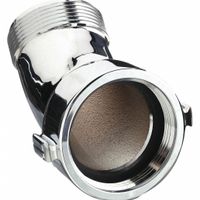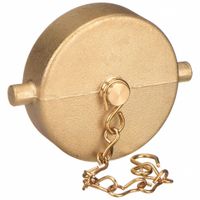Call +(254) 703 030 000 / 751 483 999 / 721 704 777
- Home
- Safety
- Fire Protection
- Fire Hydrant Standpipe Accessories
.....Read More
Frequently Asked Questions
What are the different types of fire hydrant and standpipe accessories?
Fire hydrant and standpipe systems are essential components of fire protection infrastructure, and they require various accessories to function effectively. Here are the different types of accessories associated with these systems:
1. **Hydrant Valves**: These control the flow of water from the hydrant. They include gate valves, butterfly valves, and ball valves, each offering different levels of control and durability.
2. **Hydrant Caps and Chains**: These protect the hydrant outlets from debris and damage. Caps are often attached with chains to prevent loss.
3. **Hose Connections and Adapters**: These allow hoses to be connected to hydrants or standpipes. They come in various sizes and thread types to match different hose specifications.
4. **Nozzles**: Attached to the end of hoses, nozzles control the direction and flow of water. They can be adjustable for different spray patterns and pressures.
5. **Pressure Regulators**: These ensure that water pressure remains within safe and effective limits, preventing damage to hoses and equipment.
6. **Wrenches**: Specialized tools used to open hydrant valves and remove caps. They are designed to fit specific hydrant models.
7. **Storz Connections**: Quick-connect couplings that allow for rapid hose attachment and detachment, commonly used in modern firefighting.
8. **Standpipe Outlets**: These are connection points on standpipe systems where hoses can be attached, often equipped with valves and pressure gauges.
9. **Fire Department Connections (FDCs)**: External connections that allow fire departments to pump additional water into the standpipe or sprinkler systems.
10. **Check Valves**: Prevent backflow of water, ensuring that the system remains pressurized and uncontaminated.
11. **Pressure Gauges**: Installed on standpipes to monitor water pressure, ensuring the system operates within safe parameters.
12. **Drain Valves**: Allow for the removal of water from the system to prevent freezing and damage in cold climates.
These accessories are crucial for maintaining the functionality and reliability of fire hydrant and standpipe systems, ensuring they are ready for use in emergencies.
How do you use a fire hydrant wrench?
To use a fire hydrant wrench, first ensure you have the correct type of wrench, typically a pentagon-shaped socket wrench designed for hydrant nuts. Approach the fire hydrant and locate the operating nut, usually found on top of the hydrant. Position the wrench over the operating nut, ensuring a secure fit. Turn the wrench counterclockwise to open the hydrant. This action will release water pressure and allow water to flow. If the hydrant has multiple outlets, ensure the desired outlet is open by removing the cap with the wrench. Once the operation is complete, turn the wrench clockwise to close the hydrant, ensuring it is tightly shut to prevent leaks. Always follow local regulations and safety protocols when operating a fire hydrant.
What is the purpose of fire hydrant and standpipe caps and plugs?
Fire hydrant and standpipe caps and plugs serve several critical purposes in maintaining the functionality and integrity of fire protection systems.
1. **Protection from Contaminants**: Caps and plugs prevent debris, dirt, and other contaminants from entering the hydrant or standpipe. This is crucial to ensure that the water supply remains clean and unobstructed, allowing for efficient water flow during emergencies.
2. **Preventing Unauthorized Access**: They act as a deterrent against unauthorized use or tampering. By covering the outlets, caps and plugs help prevent individuals from accessing the water supply for non-emergency purposes, which could deplete resources or damage the equipment.
3. **Maintaining System Integrity**: Caps and plugs help maintain the internal pressure and integrity of the system. They prevent leaks and ensure that the system is ready for immediate use when needed by firefighters.
4. **Weather Protection**: These components protect the hydrant and standpipe from weather-related damage. They shield the outlets from freezing temperatures, which can cause water inside to freeze and expand, potentially damaging the system.
5. **Safety**: By covering sharp or protruding parts of the hydrant or standpipe, caps and plugs reduce the risk of injury to pedestrians and maintenance personnel.
6. **Identification and Maintenance**: Caps and plugs can be color-coded or marked to indicate specific information about the hydrant or standpipe, such as water pressure or flow rate, aiding in maintenance and operational efficiency.
Overall, fire hydrant and standpipe caps and plugs are essential for ensuring that fire protection systems remain operational, reliable, and safe for use in emergencies.
How do fire hydrant and standpipe adapters work?
Fire hydrant and standpipe adapters are essential components in firefighting systems, facilitating the connection between hoses and water supply sources.
Fire hydrant adapters are used to connect hoses to hydrants, which are typically equipped with standardized outlets. These adapters allow hoses of varying sizes and thread types to be attached securely. They are designed to convert the hydrant's outlet to match the hose's coupling, ensuring a tight seal to prevent leaks and maintain water pressure. The adapters are usually made of durable materials like brass or aluminum to withstand high pressure and harsh environmental conditions.
Standpipe adapters serve a similar purpose but are used in buildings with standpipe systems. Standpipes are vertical water pipes installed in multi-story buildings, providing firefighters with a ready water supply on each floor. Standpipe adapters connect the fire hose to the standpipe outlet, which may have different thread types or sizes. These adapters ensure compatibility between the standpipe system and the firefighting equipment, allowing for efficient water flow during emergencies.
Both types of adapters often feature quick-connect mechanisms, such as quarter-turn or snap-on designs, to expedite the connection process during critical situations. They may also include features like swivel connections to prevent hose kinking and facilitate maneuverability.
In summary, fire hydrant and standpipe adapters are crucial for ensuring compatibility and efficient water delivery in firefighting operations. They enable quick and secure connections between hoses and water sources, adapting to various sizes and thread types to maintain optimal performance under high-pressure conditions.
What are the standard thread sizes for fire hydrant connections?
Standard thread sizes for fire hydrant connections in the United States are typically governed by the National Standard Thread (NST), also known as National Hose (NH) thread. The most common sizes are:
1. **2.5-inch NST (NH):** This is the standard size for most fire hydrant hose connections. The thread pitch is 7.5 threads per inch.
2. **4.5-inch NST (NH):** This size is often used for the steamer connection, which is the large port on a fire hydrant. The thread pitch is 4 threads per inch.
In addition to NST, some regions may use different standards:
- **National Pipe Straight Hose (NPSH):** Sometimes used for smaller hose connections, typically 1.5 inches in diameter.
- **Local Variations:** Some areas may have unique thread standards, such as Chicago Fire Department Thread (CFD) or New York Fire Department Thread (NYFD), which are specific to those cities.
- **International Standards:** Outside the U.S., other standards like British Standard Pipe (BSP) or Storz couplings may be used.
Adapters are often required when connecting hoses with different thread types or sizes.
How do you maintain fire hydrant and standpipe accessories?
To maintain fire hydrant and standpipe accessories, follow these steps:
1. **Regular Inspections**: Conduct bi-annual inspections to check for visible damage, leaks, or obstructions. Ensure that hydrants and standpipes are accessible and not blocked by debris or vegetation.
2. **Lubrication**: Apply appropriate lubricants to the operating nuts and caps to ensure smooth operation. This prevents rust and corrosion, which can impede functionality.
3. **Pressure Testing**: Perform annual pressure tests to ensure the system can handle the required water pressure. This helps identify leaks or weaknesses in the system.
4. **Flow Testing**: Conduct flow tests to measure the water output and ensure it meets the necessary fire-fighting requirements. This should be done annually or as per local regulations.
5. **Valve Operation**: Operate all valves to ensure they open and close fully. This prevents them from seizing up due to infrequent use.
6. **Cleaning**: Clean the exterior of hydrants and standpipes to remove dirt and corrosion. This includes painting hydrants to prevent rust and ensure visibility.
7. **Cap Maintenance**: Check and replace any damaged or missing caps. Caps protect the threads and prevent debris from entering the system.
8. **Thread Inspection**: Inspect the threads on the outlets for damage or wear. Repair or replace as necessary to ensure a secure connection for hoses.
9. **Record Keeping**: Maintain detailed records of all inspections, tests, and maintenance activities. This helps track the condition and performance of the system over time.
10. **Training**: Ensure personnel are trained in proper maintenance procedures and emergency operation of hydrants and standpipes.
By following these steps, you can ensure that fire hydrant and standpipe accessories remain in optimal working condition, ready for emergency use.
What are the safety precautions when using fire hydrant and standpipe accessories?
1. **Personal Protective Equipment (PPE):** Wear appropriate PPE, including gloves, helmets, and eye protection, to prevent injuries from water pressure or debris.
2. **Training and Familiarization:** Ensure all personnel are trained in the operation of fire hydrants and standpipes. Familiarize yourself with the specific equipment and its operation procedures.
3. **Inspection and Maintenance:** Regularly inspect hydrants and standpipes for damage, leaks, or obstructions. Ensure all components are in good working condition.
4. **Clear Access:** Keep the area around hydrants and standpipes clear of obstructions to allow easy access during emergencies.
5. **Proper Tools:** Use the correct tools and equipment, such as hydrant wrenches, to avoid damaging the hydrant or standpipe.
6. **Pressure Awareness:** Be aware of the water pressure in the system. Open valves slowly to control the flow and prevent water hammer, which can cause damage or injury.
7. **Communication:** Maintain clear communication with team members during operation to coordinate actions and ensure safety.
8. **Secure Connections:** Ensure all hose connections are secure to prevent leaks or hose detachment under pressure.
9. **Environmental Conditions:** Be mindful of weather conditions, such as ice or rain, which can make the area slippery and hazardous.
10. **Emergency Procedures:** Have a clear understanding of emergency shutdown procedures in case of equipment failure or other emergencies.
11. **Signage and Marking:** Ensure hydrants and standpipes are clearly marked and visible, with signage indicating their location and operational instructions.
12. **Avoid Tampering:** Do not tamper with or misuse hydrants and standpipes, as this can lead to malfunction or reduced effectiveness in emergencies.


